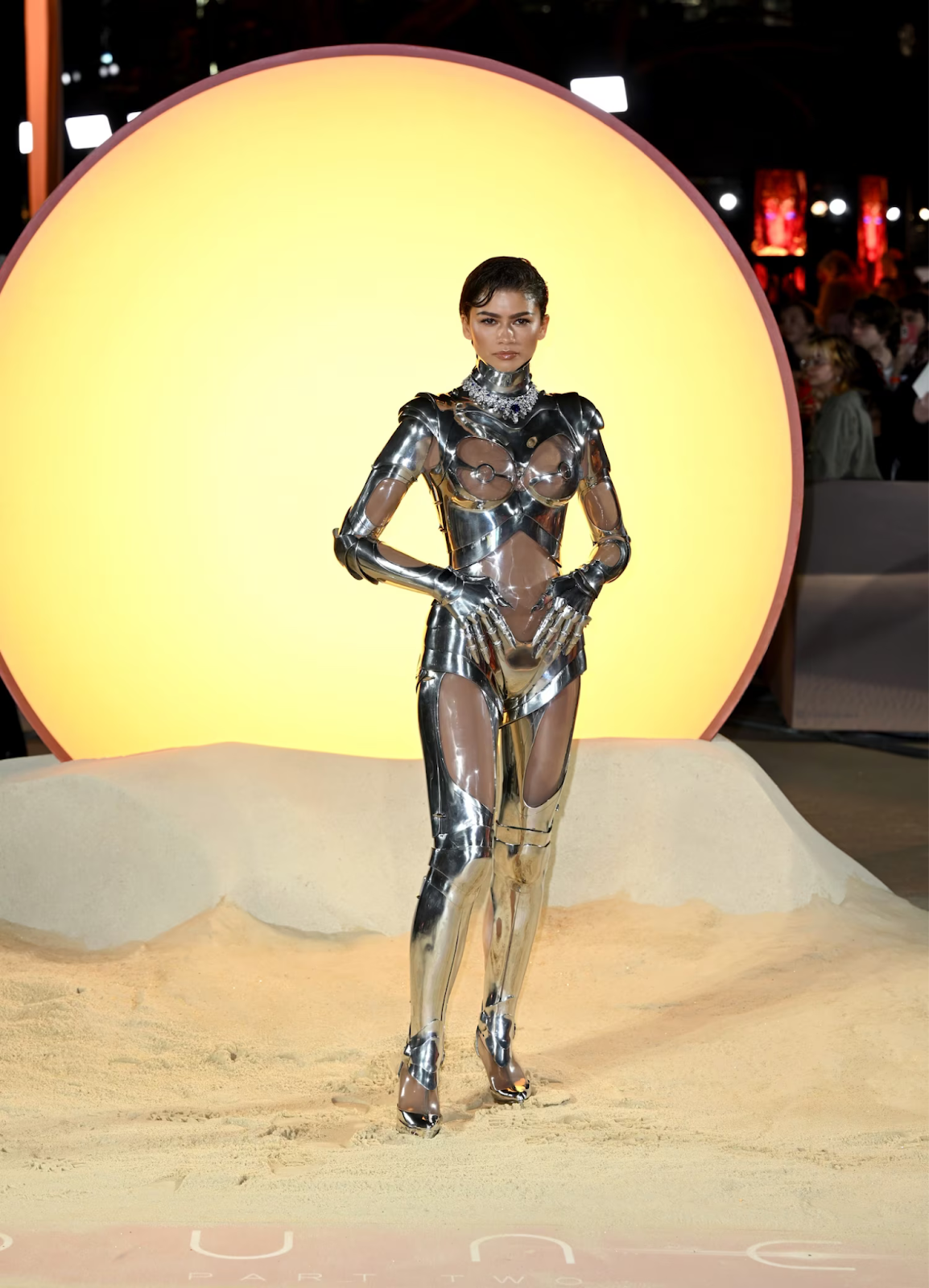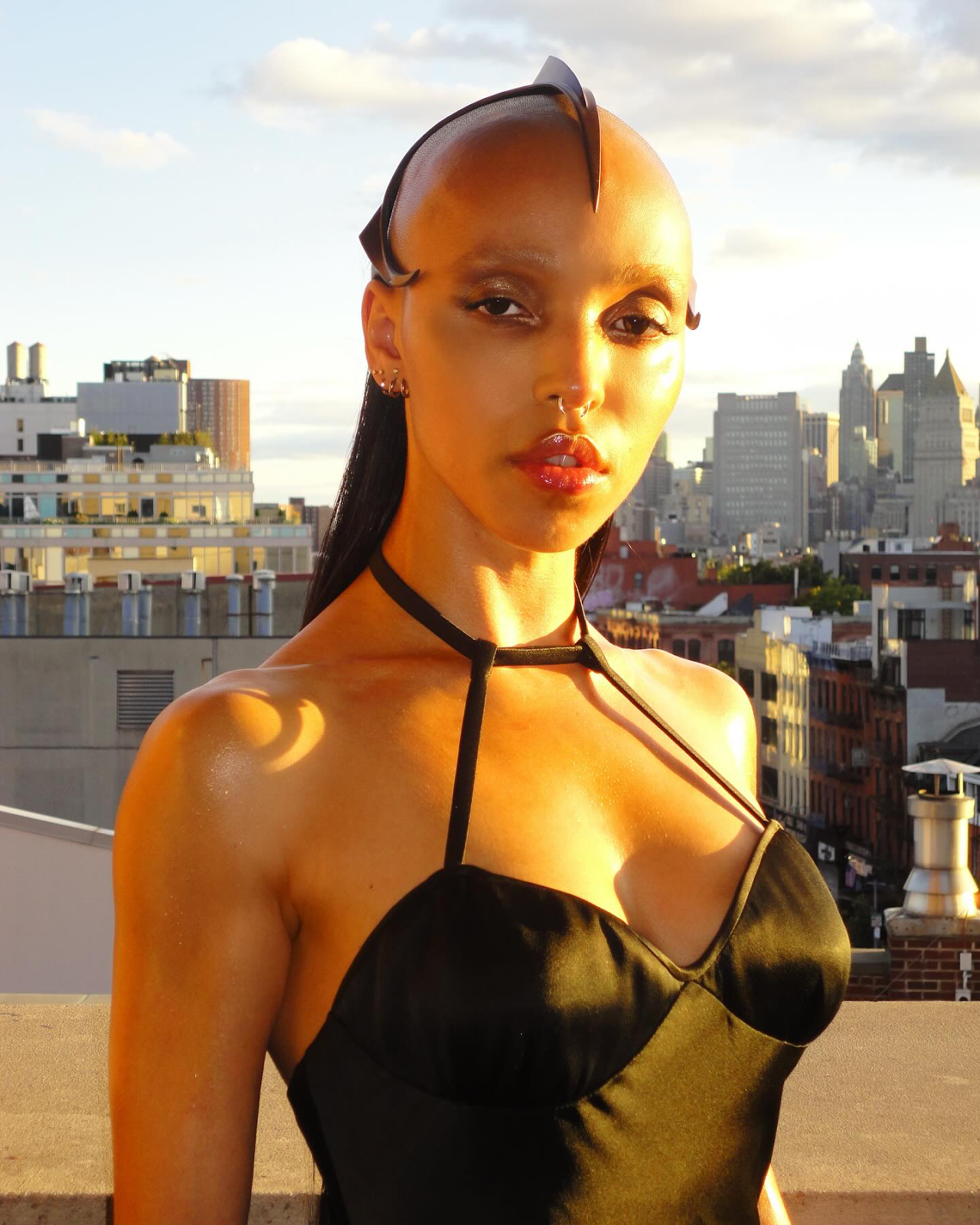Method Dressing
Zendaya for Dune: Part II. Its homeworld, of Frank Herbert’s design, bears little technology, thanks to a crusade against computers. Yet, in the face of desolation, Zendaya breathed new life into the stillsuit at the world premiere in Leicester Square, wearing archival Mugler, Autumn/Winter1995-1996. She is unafraid to pull from the past to emanate futurism. Photos by Gareth Cattermole, courtesy of Getty Images, and made available via ABC News. © All rights belong to their respective owners. No copyright infringement intended.
In a day and age of widely publicized celebrity antics, we have all learned about the absurdity of the method actor by now—more often than not against our will. What began as a surefire technique to get to the nucleus of a character has become a hallmark of its realizer going off the rails, slipping beyond the confines of their everyday self to inhabit a persona of the imagined. The intended result is edge and gravitas, poised to make the subject’s interstitial on-set performance “more real.” Yet, whether it’s Phoenix or Leto (markedly, both inheritors of the Joker role—funnily enough, perhaps the go-to fictional paragon of entropy), the “rawness” in method acting by and large comes across as vanity: a pitiful excuse to indulge in toxic behavior, unsurprisingly from the male specimen amid Hollywood’s elite.
Enter method dressing, a seemingly new step in the iterative process behind a film’s promotional rollout and release. Popularized by the face that launched a thousand bombshell wannabes, Margot Robbie, in the leadup to Barbie, pulled off best by Zendaya many times over, it unquestionably conveys greater value to the marketing of a motion picture than the hijinks of a Stanislavski caper, accruing more than just mere controversy points. It represents the act of emulating a film’s atmosphere through fashion at high-calibre events months (and, in some perplexing instances, even years) after the fact of wrapping up initial shoots—or reshoots, in the case of four-quadrant franchise fare, tailormade to test audience feedback—boasting fine exactitude in execution post the post-production. Call it a literal return to form; unlike method acting, the agent-compliant performer must retrace some aspect of their former presence for show, previously confined to a stint in elaborate scenery and caravan sites. In doing so, the cast (ideally) rides the wave of hype behind a project, cresting at its joyously momentous climax, bringing the blockbuster theatrics to carpeted functions as fodder for paparazzi, press, and the public alike to rejoice in the following day.
FKA twigs in vintage Armani for The Crow. While stellar, sporting her now famous skullet, it's unclear whether the look is set to embody gothic comic book femme, or her latest album, Eusexua. Method dressing can seemingly cross promotional territories. Credit: IG via @fkatwigs, made accessible through Grazia. © All rights belong to their respective owners. No copyright infringement intended.
If perfected, method dressing can surpass eye candy status, not only capitalizing significantly on a film’s marketing campaign from its early to end stages as yet another strategy to fuel ticket sales, fostering awareness of the product and its intellectual property, but taking it from tie-in material for the main event to a cultural moment in and of itself. Regarding the former, I believe this is why you often see the foremost garments extract, in exaggeration, the most prototypical, stalwart “sellable” features of a film through color blocking, style, texture, and silhouette, offering an indication as to a film’s existence, genre or, otherwise, its general sensibility. In other words, how one conveys a cinematic aura can be achieved in many indefinite ways, but if you see Cynthia Erivo and Ariana Grande on a yellow brick road, draped in emerald and pearl tones, you likely know you will soon have Wicked on your hands, as well as precisely its main stars.
However, I maintain that there must be a certain “it factor” behind any method-dressed inductee for their efforts to truly transcend going down as a tactical or uninspired ploy in fashion legacy. It isn’t so much about simply riffing off another’s artistic vision, as that comes across as too insipid, nor is it about attempting to provide some wholly distinctive intellectual contribution that ultimately baffles; rather, it’s about striking a fine balance, sufficiently exquisite and inventive enough to stand out. I call it the Met Gala effect: while very much the same underlying fun and frenzy, there is more to it than Halloween, cosplay, or showing up for a theme (for more information, see Dakota Johnson’s web dress for Madame Web—although I get it, she really just wanted to cash in that cheque for a lackluster Sony offering, doomed to fail in its very own shockingly derivative conceit).
There needs to be an apparent quality, yes, reproducing something noteworthy about the film’s characteristic mise en scène (or, in Johnson’s case, its title), but also an additional wild card component that gives it that ineffable, je ne sais quoi universal appeal: being organically you whilst also the film itself. I use Zendaya as a prime success story because she seems to have these qualities on lock, unafraid to reference while pulling together a cohesive yet varied string of looks from unlikely places for the Dune: Part Two and Challengers promotional circuits—and, somehow, all in the same year. Pivoting from the brutalist wastelands of Chani’s Arrakis to the occupational grey zone of troubled sportstar Tashi Duncan in a span of mere months is no easy feat, yet Zendaya made it seem effortless, putting other recent attempts to shame (her own costars, Timothée Chalamet, Mike Faist, and Josh O'Connor, included). No look ever repeated itself, but each scaffolded a visual companion universe, every one a clever, well-calculated stunt, owing to her and stylist Law Roach’s partnership as pros, never averse to serving beyond a tennis sense. Ingenuity can be achieved in other respects, as much a skill in tailoring as it is in impeccable timing and masterful curation.
Anya Taylor-Joy for Furiosa: A Mad Max Saga, echoing the scorched metal tones of the post-apocalyptic George Miller romp. At her core, Furiosa is a character cast in iron, and Taylor-Joy provides a nuanced take on this in Balmain at a photocall in Mexico City (pictured left; shot by Jaime Nogales, courtesy of Getty Images, via WWD) and Acne Studios in a Hollywood screening (pictured right; photographer unknown, via RCFA). © All rights belong to their respective owners. No copyright infringement intended.
The worst branding offense, then, is to make no noise or bring disconnect, going down as forgotten, and it’s interesting that this is often in weighted distribution with a film’s own trajectory (how many can recall on-theme endeavors for Maleficent: Mistress of Evil, Matrix: Resurrections, and even, most recently, Joker: Folie à Deux?).
While most (thankfully) choose not to method act, it would seem that method dressing has quickly become a prerequisite for premiere occasions. Celebrities running amok in attire that exonerates the trappings of their own work—it could just as easily be shrouded in the same pretensions. Yet, the term “celebrities” may be too much of a blanket when the pressure is heavily gendered, placed primarily on women to steer the flamboyant ship. Men rarely face the same scrutiny to show out; when attempted, they either flounder at the theme—too beholden to masculine dress codes—or else lack online visibility, generating little to no traction. It inevitably turns into a blame game whereby women, in doing “too much,” are deemed try-hard or inauthentic, yet, in doing “too little,” have their fate sealed as a blunder or mishap. It’s similar to the notion of an era in music, which rampantly devolves into sexism when women in pop, particularly, are expected to have a vision behind an album to be deemed successful.
I think, while it’s largely easy to foresee how it will play out when a project is announced nowadays, many are too eager to denounce method dressing as a tired trend when it has really just begun. Sure, it’s not new, and it will probably live and die by the way most trends do, eventually to the point where it is no longer seen as fresh, eliciting only eye rolls and diminishing returns. But, until it is deemed insufferable, why not relish in how deftly some are able to replicate a constellation of a film’s aesthetic, owing itself as both an asset and tribunal to their own style and versatility? After all, these are the tricks of the trade, wielded masterfully for the trades; don’t hate the player, hate the game.






